I have always thought it was a real shame that our vintage horns couldn’t tell us about their pasts. It would be fascinating to know who they belonged to; or what kind of music they played; or for that matter, what kind of bands they were played in.
Well, a few weeks ago an auction ended on the UK eBay site, for a horn whose once-owner had a fascinating history.
The sax that I’m referring to is a King Super 20 Silver-Sonic alto, that at one time belonged to the legendary Chester Hazlett. Hazlett was a saxophonist/clarinetist for arguably the most popular dance band leader in the US during the 1920s: Paul Whiteman.
Whiteman was often referred to by the press as the King of Jazz. However, when the 1930s swing band era came in, Whiteman apparently was not able, or willing, to switch to that style of music, and found his popularity fading. By the 1940s he was semi-retired from music.
Since this Super 20 was clearly built post 1920s—it is circa 1947—Chester Hazlett would have owned it after his busy playing days with the King of Jazz. Nonetheless, the fact that it was once owned by such a well known musician makes this an interesting piece of saxophonic history.
Source: ebay.co.uk
Source: ebay.co.uk
The seller of this King Super 20 Silver-Sonic, described the sax like this:
This King Super 20 alto saxophone is being sold on behalf of my wife’s grandfather, George Nuttall, who will be 90 next year and would like the saxophone to go to a good home. He was a semi-professional saxophonist for approximately 60 years and bought the saxophone from a London shop called La Fleur in the early 1950s. Unfortunately, he can’t find the receipt, but knows that it was the most expensive saxophone in the shop at the time.
The saxophone has the name of Chester Hazlett inscribed on it, and it once belonged to Hazlett, who was a member of the famous American Paul Whiteman Orchestra. We believe, based on the dates involved, that George was the second owner (after Chester Hazlett), but that is not certain.
The saxophone is numbered 295197, has its original gold lacquer with mother of pearl buttons, silver crook and bell. The hardwood case was supplied with the saxophone when it was bought. It has the name Buescher Elkhart, Ind on the outside and is covered in black rexseen with blue velvet and has a two compartment interior.
The saxophone was last serviced ten years ago, when it was repadded and the springs checked.
We would be prepared to put anyone with serious interest in purchasing the instrument in contact with George, if they would like to discuss the details of the instrument in further detail.
Source: ebay.co.uk
Based on the description, Hazlett only owned this sax for a few short years. Regardless, Chester Hazlett is a name from the early days of American jazz music that is worthy of note.
Unfortunately, although there are a great many references to Hazlett on-line, I was not able to find a biography of the man, or any real concrete information. If anyone would like to chime in with some background on this early jazz saxophone icon, that would very much appreciated.
In the meantime, let’s have a listen to some music Chester Hazlett performed with Paul Whiteman and His Orchestra. My Blue Heaven was recorded on July 6, 1927, in New York.




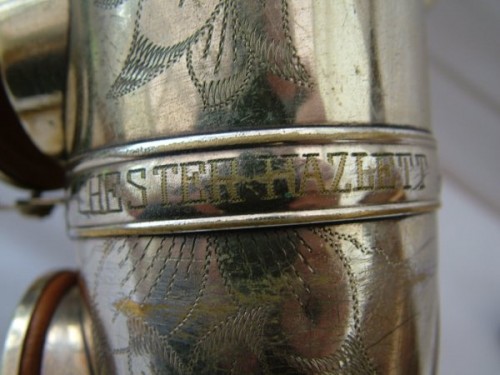
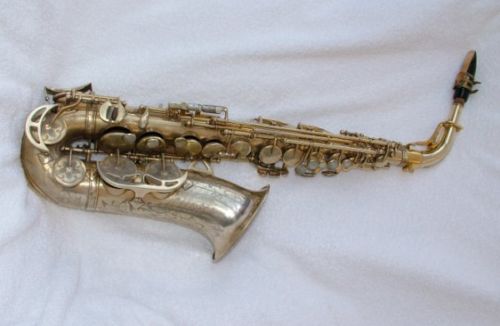
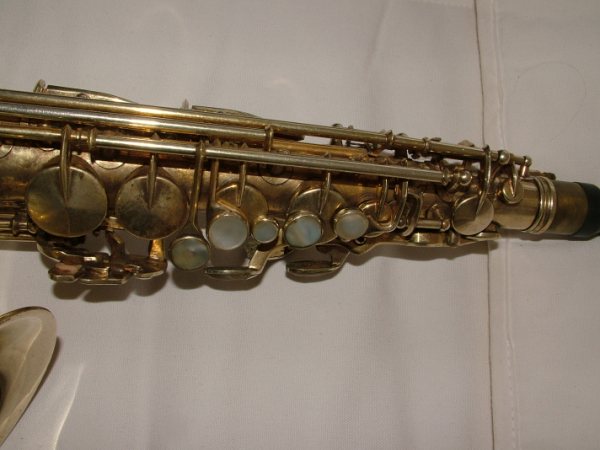
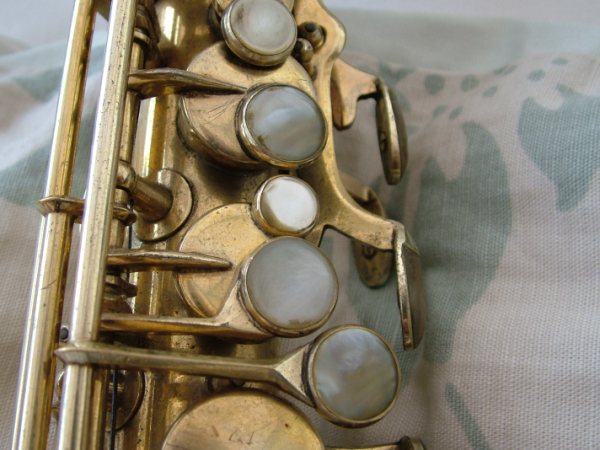
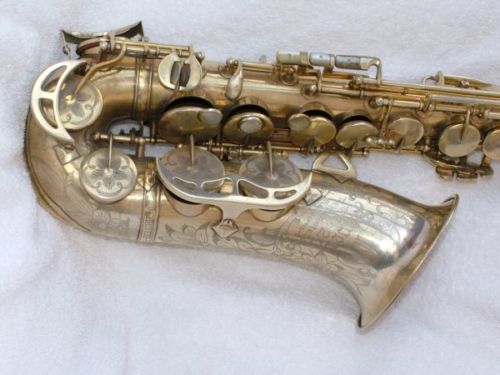
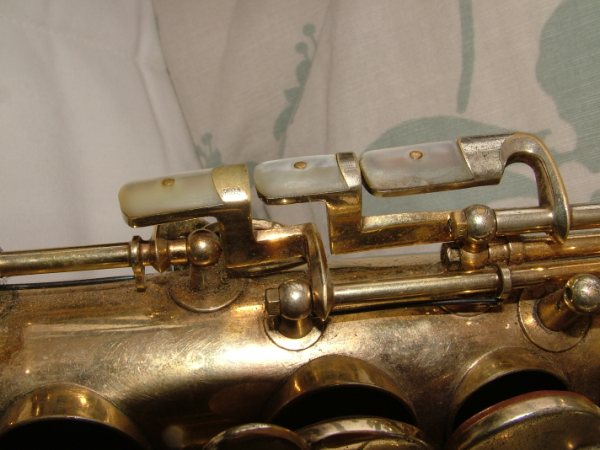
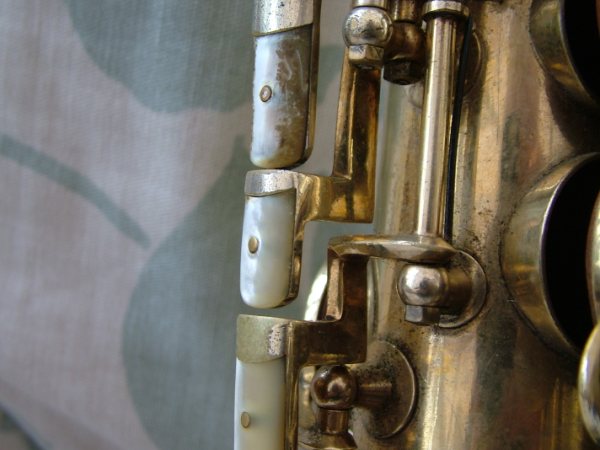
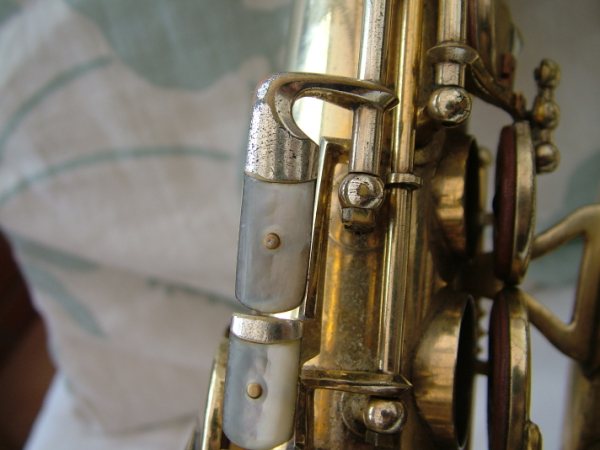
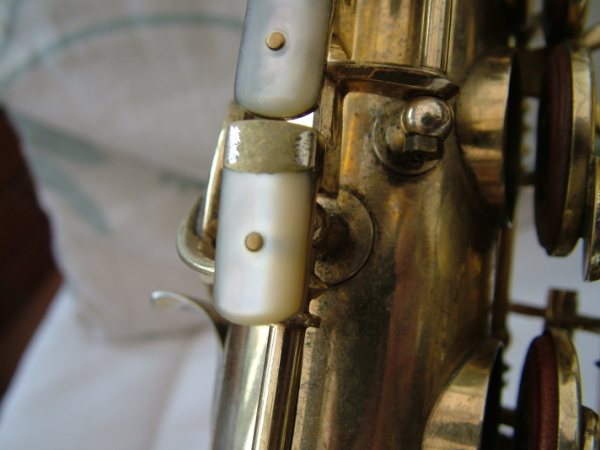

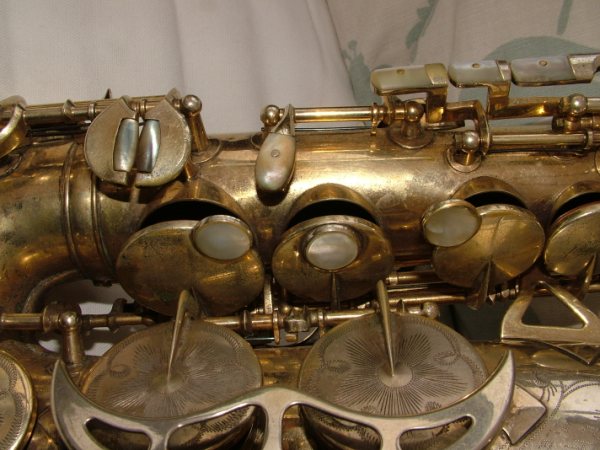


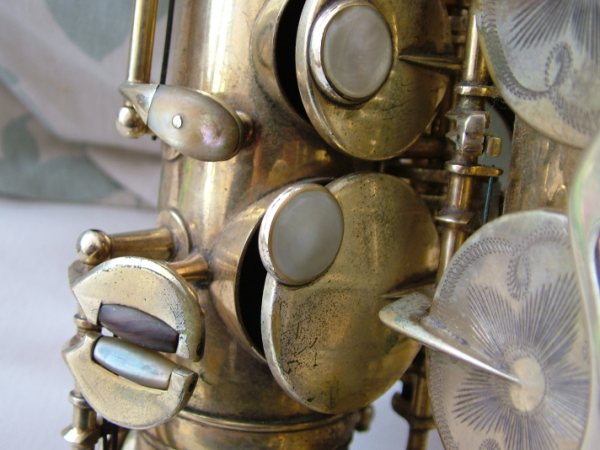
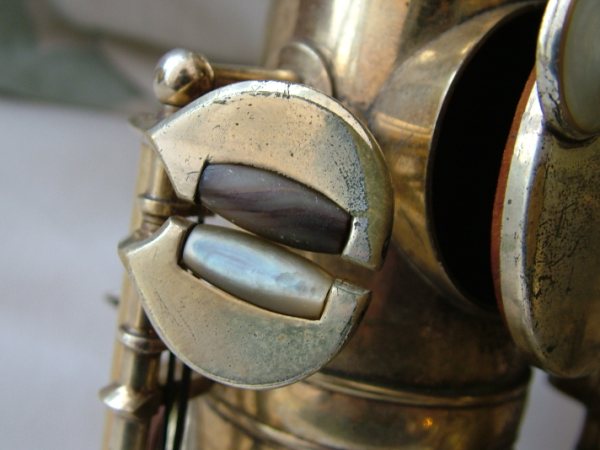


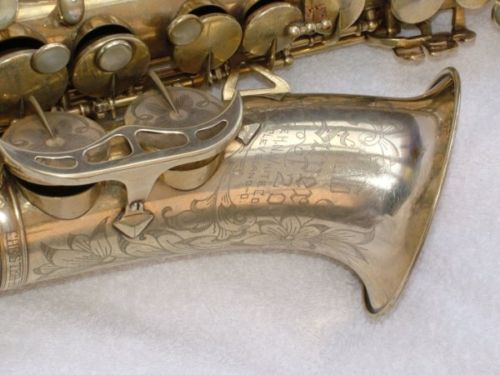
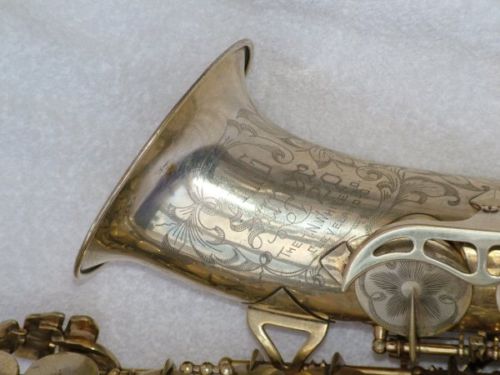




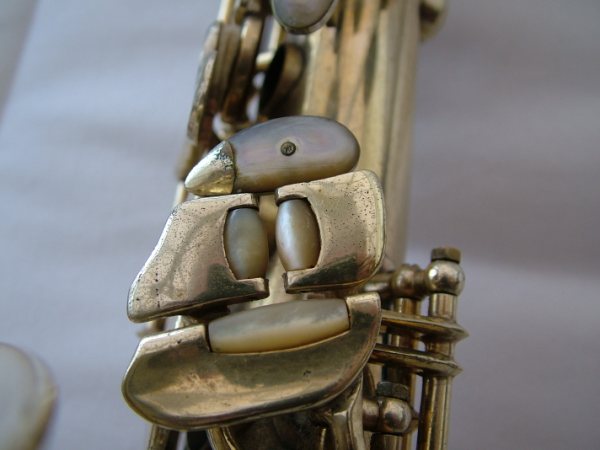
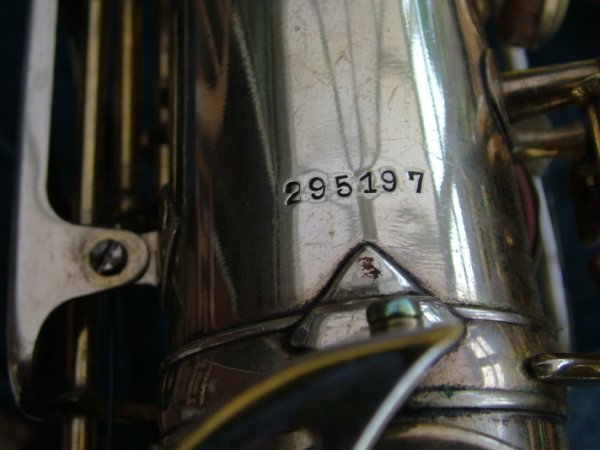
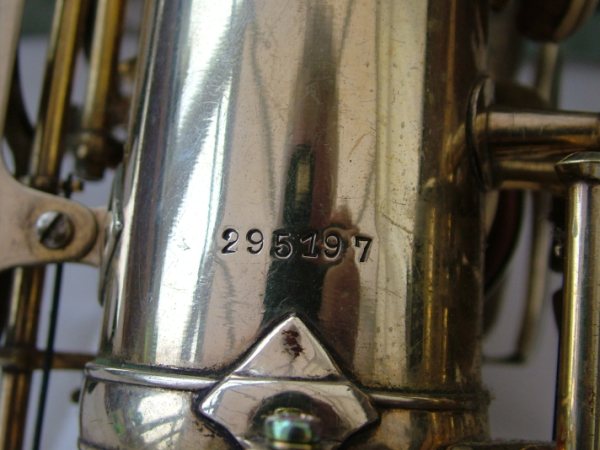

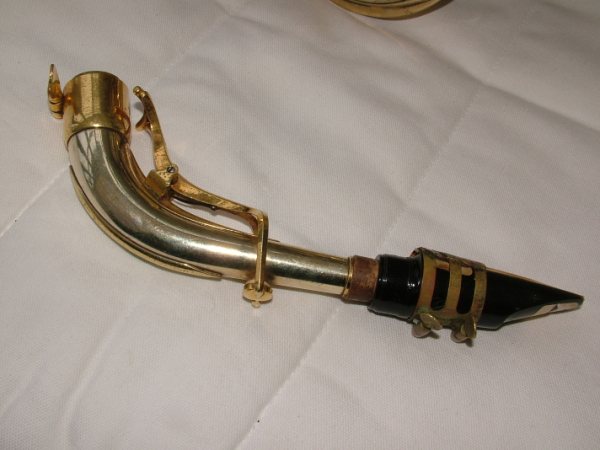
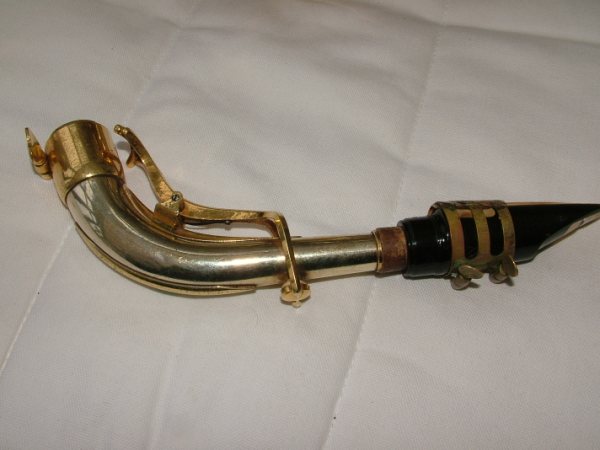
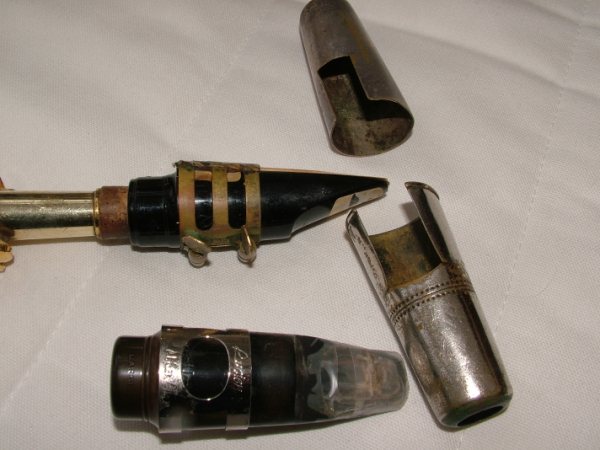


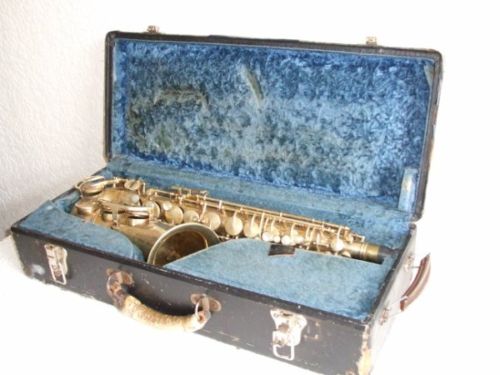

Anybody still seeing this after a few years, I would love to talk to someone who could get me more information on Chet Hazlett. I am his great grandson, son of Mark Hazlett, who was the son of Robert Hazlett, all found on ancestry.com today. It has been a thrilling and amazing discovery thus far. My last name was changed to Lumbra as a child. mrtlumbra@hotmail.com
Hello Adam,
My name is Steven Benson. My mother is Suzanne Hazlett Benson. She is Chet and Ethel’s daughter, Nancy and Robert’s sister. I spent half of my childhood in the company of Pappy (Chet), Grandma, Bob, Nancy, Mark, Randy and your grandmother Shirley. I visited them on holidays, weekends and school and summer vacations. Mark and I did a lot together. He was my cousin but really a big brother to me. But back to Chet. The orchestras he played for, that I know of, were the San Francisco Symphony, Paul Whiteman and the NBC Symphony. He spoke of a very nice young man, pianist/songwriter George Gershwin, who hand a song (Rhapsody in Blue) he wanted to introduce with Paul Whiteman’s band. He taught students in his home to play clarinet, saxophone, flute and violin until he died. He was a very good golfer. I remember a big trophy in his home. He shot a hole in one on the same hole two days in a row. He was even good at bowling. What you really need to know about is what a wonderful grandfather he was. He made up bedtime stories to put his grandsons to sleep. He tied a sled to his car and towed me around on the snowy airport runway in Turners Falls, Mass. He gave me his golf clubs with his initials I still have. I have a lot of family photos of him, his children, band members, your dad and your aunt Randy. My email is enclosed (theresabenson331@gmai.com). If you would like I can give you my phone number.
Hi,
I was the band director at Turner’s falls [ma.] High school when Chet’s son managed the airport there. Chet taught clarinet to some of my students and did a solo at one of our concerts[Mozart].
I was with him when he got a call to play with Kostelanitz on a recording for the entry of Hawaii as a state . He packed a soprano sax which had some rubber bands around a couple of the keys.
When i went to teach at a small college in New Hampshire , Chet drove up there to teach some of my students. He had a little black book with names of musicians . One clarinet player listed as a replacement for him was a Bernard Goodman.
A truly nice guy.
Hello Jacob. Welcome to my site.
I’m sorry it has taken me so long to reply to your comment.
This particular article has generated so much interest, it’s really quite remarkable. From the sounds of it, Chet Hazlett very much liked to give back through working with music students. Or perhaps in his retirement, he just returned to what he knew best: music. Either way, it has been my experience that no talented musician ever really gives up his craft. Over the years his/her focus might change, or how they go about expressing their musicality might change, but their inner musician can never be totally silenced.
I very much enjoyed reading your stories about Chet Hazlett. (The soprano sax with the rubber bands in particular struck a chord. The historic nature of that performance and the disrepair of his gear, is an interesting juxtaposition.) I will have to check in my dormant computer’s address book, and dig out the email address I have for the Hazlett family. Hopefully that family member still has the same address, and I can notify him of your post. I believe he will really enjoy reading it.
Thank you for stopping by and sharing your stories Jacob.
Warm regards,
Helen
Chester is my first cousin 2x removed. I have very much enjoyed reading the comments here and have passed them on to many of our family.
I had not heard the “rubber band” story before, but it very much sounds like our family. You don’t buy new if you can fix what you have.
Hello Harriett. Welcome to my site.
I’m glad that you’ve enjoyed the discussion around this article. I had actually been in email contact with a member of Chester Hazlett’s family a few years ago. I can’t remember the fellow’s name now, but he and I exchanged a number of emails. I would have to dig through my old email archives and see if I can find the communications. If I remember correctly, he and one of the comment posters also got in email contact. I believe she had been his neighbour. But again, my memory is a bit fuzzy on this, since it was a number of years ago—likely within the first few months of my writing this article—and I’ve written a lot of articles since then.
If you would like know more, get in touch with me via email, and I’ll dig through the archives, and write you more of the details.
Regards,
Helen
Hello Helen.
If this helps, would you like me to be the liaison between the Hazlett family and George’s family? I in fact, know the saxophonist personally who used to own the saxophone and I’m sure it will be easy to find the person who now has it. I’m sure something can be worked out 😀
And if anything helps, i’m sure the Hazlett would like to know the wear about in terms of the saxophone’s location because it must have been one of the really important piece of family history for them.
Liu
Whenever there’s any conversation on this post I let the Hazlett family know about it. Thank you for your offer. If they want more information, I’ll pass along your email address.
Hello, all!
I contacted my father recently to ask him about his memories of Chet Hazlett back in the 60s, when we lived next door. He used to go up to the Hazlett house at 30 Cottage Street in Orange, MA, and talk for hours about the bands Chet had played with and all of the people he knew.
I was amazed that I didn’t know how close friends my father and Mr. Hazlett were, but then I was only about 6 or 7 years old.
My father began to recount so many stories Mr. Hazlett had told him that I decided to try to get my father to write a biography of him.
Just as an example of the wealth of information my dad has in his head, when I asked about Chet ‘s memories of Bix Beiderbecke, he told me:
“You know the song ‘I Can’t Get Started with You’? Well, Chet told me that the night they recorded it, Bix had a terrible time getting through the music. He looked bad and really struggled to finish the piece and then went home and DIED!”
He then told me about Chet being a really good golfer. But after his death, my dad said he saw a huge silver trophy Chet had won in a pawn shop in Athol, MA. He went back to see if he could buy it as a momento of his friend, but it was already gone.
If the Hazlett’s would like to know more, I can put them in touch with my dad. But it’s not all happy news. I researched the remaining members of his family and his son, Robert, is dead, as are both of his grandchildren. My dad said that Chet adored his granddaughter,Randy, who died only a year after he did.
However, one of the many pleasant and interesting things my dad told me was that Chet used to own a big mansion in New Jersey at one time. When he sold it, he sold it to Ozzie & Harriet!
Wow MaryAnn. That’s very interesting.
I’ve dropped an email to the Hazlett family and let them know about your post. I’m sure that they’ll be very interested to read this.
I will send you an email. I have something to send on to you, that I’ve been meaning to do, but it slipped my mind. I just have to dig through my Inbox to find it.
Regards,
Helen
Hi Liu.
Nice to see you back. Glad to hear school is going really well.
Yes, it was really quite remarkable when I got the email from Maryanne. The Hazlett family was very pleased for the information. It’s interesting how this simple blog post that I wrote because you brought this horn to my attention, has touched so many lives. It’s quite remarkable really.
Thank you Liu, for being the catalyst that started one of the most interesting posts & discussions that this weblog has seen.
Take care. Check in again now and again when you have time…helen
Hello guys.
I simply cannot believe that someone actually lives besides Chester Hazlett responded to this post! What a delight! Yes this is quite interesting and thank you to both Helen and MarryAnn for digging so much information about his extreme talented guy. This saxophone indeed, in my opinion is like the holy grail of King Super 20s.
Oh by the way Helen, pardon me for missing in action for too long because I have been very busy in University now and its going awesome.
Nice clip that is a young Bing Crosby singing between the two pianos it is probably a clip from one of his early movies? Happy feet is one of my favorite songs It shows up regularly as back ground music in the early Looney Tunes cartoons from my child hood.
When I was a little girl back in about the early 1960s, Chester “Chet” “Pappy” Hazlett was my next-door neighbor. My Dad knew who he was but I didn’t. I actually took some clarinet lessons from him! He was giving lessons to kids to supplement his retirement, if there was any.
My brothers and sisters and I used to put on little performances for him and “Grammy” Hazlett, his wife.I do not know her first name. He owned a boxer dog named George, who used to get into it with our dog, causing hysterics.
He had a son named Robert, a grandson named Mark, and a grandaughter, Randy, who died a teenager.
He was a kind man who was living out his life in obscurity in a little old New England factory town of Orange, Massachusetts.
I really was pretty unaware of the history of the old man living next to me, but my Dad used to go chat it up with him. I will ask him what he remembers of those conversations.
I am really sad now that I never heard him play—or bought up one of his old instruments at a tag sale! 😆
Hello MaryAnn. Welcome to my site.
What a wonderful story. It’s amazing how many of these great musicians of the past lived the later part of their lives in obscurity. I would love to be able to say that I took lessons with XXXXX as a small child. What a wonderful story that would be. Do you still play the clarinet?
I received an email from a member of the Hazlett family. It was from a man whose grandfather was Chester Hazlett’s brother. Apparently music ran in the family, and a number of the family members were musical, and Chester’s brother—an organ and piano player—owned a music store in California.
I’m going to point your comment out to the Hazlett family. They are currently gathering family information for their children. I think they will really like your story MaryAnn. Thanks for dropping in and sharing it.
Regards,
Helen
Thank you, Helen, for your kind welcome to this very interesting site!
Since finding this material on your site, I have tried to do some research on the kind, humble man I knew as a child. I must say that I am very sorry not to have been able to find a concise biography of this super-talented musician, in whose honor mouthpieces were named and new clarinets were advertised.
I have begun listening to a lot of his music and learned a bit about his contemporaries. Just as an example of the height to which his career at one time soared is that one of his early bandmates was in fact Bing Crosby. In fact, it seems that in looking back at the great bands of the Jazz era, anyone who was anyone played with Chet Hazlett.
Here is my favorite song so far in my research:
http://www.last.fm/music/Paul+Whiteman/_/Happy+Feet
I added his gravesite to the virtual cemetery FindAGrave, since after much searching, I cannot determine the circumstances of his death in 1974 nor his burial location. I felt that he deserved to be remembered to his many fans and accorded some tribute to this very talented musician.
I include the best photo of him as a young musician that I have thusfar been able to find.
I want to thank you for hosting this site, as it has really effected me to learn that I lived next to one of the greatest woodwind players of all time. I have become a great fan at long last, regretting only that he was not more celebrated in his older years as the fantastic musician he was.
Hi there MaryAnn.
It is a pleasure to have you here.
I’m so very glad that my site has been the catalyst in your quest for learning more about your childhood next door neighbor, Chet Hazlett. I did forward the link to your first comment on to Chester Hazlett’s family, and did receive a reply. I’ve been meaning to send you an email. The family is most appreciative. I will forward their comments to you. I will also let them know of your most recent comment as well.
I’ve been meaning to email someone else, who might be able to shed some light onto this particular saxophone. (The King Silver-Sonic Super 20 alto that I wrote about in the original post.) I will try and do this today. I think that would be interesting as well. It is unclear what happened to Chester Hazlett’s instruments after his death. Perhaps we can at least find out more about the origins of one of them.
Update: I realize I never did a separate note about the auction’s outcome. A tad late, but nevertheless here we go…
Yes, this horn–that at one time briefly belonged to Chester Hazlett–did sell. The selling price was 3,901.00 GBP. Since I didn’t convert the price at auction’s end I can’t tell what the buyer paid then, but as of today, that price would be 6,015.10 US, according to XE.com.
Hello Helen,
you will be quite surprised that I actually read a biography about a man, whose name is Al … something (sorry, bad memory) and the biography talks about him ‘replacing’ Chester Hazlett. I should have saved that page when I read it as it can give us a good indication in terms of year and date in which, like what you said Chet being fired by Paul Whiteman. Do you know the reason why?
And yes, the photo I have found is actually quite common, look it up at any search engine for images and poof, there it is. BUT, the one that has all the names on it, it took me quite a while.
Maybe it is a good idea you give Chris a message, see if he will be able to dig up any information about it. My bet? Is that during a period of time, King specially produced horns specifically for pros. I rarely see gold plated King Super 20s like that, after series 2, except one on saxpics.
As far as like what you say about the price, I think given a few years time, IF there is another ‘jazz wave’ that will consume the generation again, I predict that Altos may be a bigger investment than Tenors, JUST BECAUSE Charlie Parker plays one. I’m not saying that tenors are not as valuable as altos, in fact, their prices nearly ALWAYS surpasses altos! I think only SPECIFIC horns, you will be able to get prices, as so. With £4000, you can pretty much get any dream horn you like already!
Nonetheless, tenors are great, and my technician warned me … “Once you go tenor, you won’t go back to alto.” 😀
No need to apologize for the multiple posts. I have unlimited server space. 😀
You might have noticed that I added something to my previous reply to you that I forgot to add the last time around. I knew Hazlett’s horn was a Series IA, but I forgot to add the differences between the I & IA, once I had the info on the I posted. 😳 I tweaked the language as well to make my comment clearer. I figure you likely know this stuff already, but lots of others who might read this may not. That’s why I always add so much background filler to all my comments, no matter who I’m replying to.
What a great picture you found of the Paul Whiteman Orchestra in 1928. I did not know that he was the section leader. Not bad for a guy who was briefly fired by Whiteman at one point. I’m not sure when that firing took place. None of the research I came across gave a year, or an exact time period.
I understand what you’re saying about the value of these collector horns that may have been especially done up for pros of the day by King. Just as an aside, I wonder if Chris from hnwhite.com would have any info on that, or if those records too would have been destroyed, along with the rest of the old King records, when the company was sold. In the case of something special however, copies of records may have been kept, and Chris might have a record of them. It might be worth checking with him. Specifically, I’m wondering if King did up horns specially for high profile pros, or if these were just production line horns with names engraved.
As far as prices goes, the only Super 20s that I’ve seen go for more than $7,000 are tenors. (But then I tend to watch tenors more than anything else.) Altos–or baris for that matter–don’t seem to bring the same amount of money that the tenors do. I’ve just assumed it’s because we tenor players are crazy. 😉
Sorry for the multiple posts 😉
Take a look at Bird’s King Super 20.
Compare and contrast. Pretty much the same really. 😮
And quite honestly, I think it didn’t reach its maximum market value. How often do you get to see a gold plated King Super 20 tranny, owned by (arguably) one of the top saxophone players during the 1930s which he used during the 40s? It is pretty much like Parker’s horn on ebay, only lesser hype!
Still, I have seen minty series 2 Silver Sonics with gold leaves go for … nearly USD 10,000~. Sometimes, it is quite true about what you say, how much value is to the saxophone, is how the person perceives it.
In my honest opinion, this should have gone for a bigger bomb. A much bigger one in fact.
I wonder how it sounds sonically.
Do not forget, this saxophone seems extremely pimped up. Unless we’re talking about Parker’s horn, which EVERYONE knows about it, this is pretty much the ‘closest’ you can ever get near the grade, craftmanship and build during the 1947 period. Look at the serial and compare it with Parker’s. It’s only a few away!
Nonetheless, the saxophone looks absolutely stunning. Parker plays a Series 1a as well, or most of his recordings. And I have no true records of Chester Hazlett stating the saxophone that he uses in his recordings as well. Still, you have to know that only a few selected few are in the Paul Whiteman Orchestra. Chester has been the saxophone band leader in his section.
Here’s a photo in 1928 that I have sourced out during my free time. And thanks for sending an email to the American Jazz Museum as well. They have not gotten back to me, and i presume they disregarded the fact that I was being serious in my inquiry.
From what I can see from the photo, it seems to be gold plated. It looks very pimped up. As comparing to Zephs and 20s, sonically I think they sound pretty much the same. Unless you’re talking about the later models which they alter specifications of it. Nonetheless, Zephyrs and King Super 20s are legendary horns.
I wonder what is the true value of such a collector horn like this?
While doing research for today’s post I refreshed my memory about these early Super 20s, and took a look at some very pretty pictures of lots of Silver Sonics on SaxPics.
I’m sure you’re right in that this sax is most likely gold plated. It would make sense that it was, since that finish was available, and would have been the most expensive of the finish options. The ornamentations that we see on the horn, all came standard on the first Series of Super 20s.
This is what it SaxPics says about these Series I horns:
This particular horn of Hazlett’s seems to be of the Series Ia (Transitional) variety. Their serial number range was 295xxx to 305xxxx.
This is what SaxPics says specifically about how these Tranny horns differed from the Series I saxes:
I also found this interesting old ad on the hnwhite.com website. It lists the 20 Points Of Excellence of the new Super 20 horns. So I can only assume that according to King, these are the differences between the Zephyr and Super 20.
Later the Zephs did morph into almost an intermediate level horn. That happened once the company was sold though I believe.
As far as value for a horn like this goes, I think it sold for its value. It brought 3,901.00 GBP, which XE.com tells us is $5,971.22 US today. Frankly, I’m surprised it sold for as much as it did. Chester Hazlett is not that famous a player. Hazlett only owned the horn for a couple of years, and must not have done many recordings, if any, with it. If it had belonged to someone like Earl Bostic, I could see the price being that.
In the end, collectible value is really in the eyes of the collector. From a player’s perspective, there are minty horns of this generation available for that amount of money, or less. Chris, who owns hnwhite.com, has some lovely examples for sale occasionally. He’s my go to guy for this kind of stuff.
Mmm…. :scratch: So the American Jazz Museum hasn’t replied to you. Maybe I should send them a note as well. Getting another inquiry might make them think about it a bit more, and realize that it wasn’t a joke. I’ve had others link to this article, so Chester Hazlett isn’t that unpopular, or unknown.
A yes, Super 20s… They are very nice. But I must say, the Zephyrs are very nice too. My 1950 Zephyr is a killer horn, and has a number of the advances that King put into the early Super 20s.
While the Zephs weren’t as flashy as those early S-20s, they delivered the goods. I see the Zephyr a bit like the Ford truck of saxophones, as compared to the Super 20 that would be more along the lines of a Lincoln Navigator. Both will get you where you’re going, but one will look a whole lot prettier during the trip.
Hello Helen,
I have contacted them ages ago, but they have not contacted me back. I’m pretty sure they will just blow it of as someone who is joking. Nevertheless, I’m still trying to source out as much as I can. I watched the ‘Boys of the Band’ extract from the ‘King of Jazz (1930)’ and you can clearly see there are a lot of extremely talented musicians, including Chester Hazlett! I am just extremely curious in which the link you have provided, and the recording he is involved. I am VERY surprised that the King Super 20 was his choice, and it seem custom made, just like Parker’s 20. And what is astonishing, is that he passed away in the same year as Cannonball Adderley! And he USED a King Super 20 as well.
I sense a trend now. I think it was a message they are trying to get across to the current generation: King Super 20. Hands down. Just my opinion 🙂
Liu
My name is Steven Benson. My mother is Suzanne Hazlett Benson. She is Chet and Ethel’s daughter, Nancy and Robert’s sister. I spent half of my childhood in the company of Pappy (Chet), Grandma, Bob, Nancy, Mark, Randy and your grandmother Shirley. I visited them on holidays, weekends and school and summer vacations. Mark and I did a lot together. He was my cousin but really a big brother to me. But back to Chet. The orchestras he played for, that I know of, were the San Francisco Symphony, Paul Whiteman and the NBC Symphony. He spoke of a very nice young man, pianist/songwriter George Gershwin, who hand a song (Rhapsody in Blue) he wanted to introduce with Paul Whiteman’s band. He taught students in his home to play clarinet, saxophone, flute and violin until he died. He was a very good golfer. I remember a big trophy in his home. He shot a hole in one on the same hole two days in a row. He was even good at bowling. What you really need to know about is what a wonderful grandfather he was. He made up bedtime stories to put his grandsons to sleep. He tied a sled to his car and towed me around on the snowy airport runway in Turners Falls, Mass. He gave me his golf clubs with his initials I still have. I have a lot of family photos of him, his children, band members, your dad and your aunt Randy. My email is enclosed (theresabenson331@gmail.com). If you would like I can give you my phone number.
Hello Helen,
I have found out about Chester ‘Chet’ Hazlett that he lives in Tenafly, New Jersey. The source I have gotten from is a someone who is a friend of Joe Allard who passed away, in which was told by Joe about his encounter with Chet and them working together. As you mentioned before, interestingly that there isn’t much lore about this particular saxophonist, even he is very reknown during the 1930s. Quite a shame. I’m still digging as much information as I can and I am still waiting for the American Jazz Museum to get back to me.
Liu
Hi Liu.
Welcome to my website.
Although at first glance it seems surprising how little “real” information is out there about the man, in fact it’s perhaps not that surprising at all.
If we think about all the session musicians who worked more recently than Hazlett–just think of some the great Motown players–many of them are virtually unknown to us. If we do find a name or two, finding out history about them is very difficult as well. Furthermore, there are many session musicians who were never given credit for the work that they did.
What is perhaps surprising, is that Hazlett has as many references on-line as he has. I think this a wonderful validation for a lifetime of work in a profession were anonymity is often commonplace.
It will be interesting to see if the American Jazz Museum will have any information on Chester Hazlett. Please post an update here when you hear from them Liu.
Thanks for the visit.
Regards,
Helen
I did find this interesting piece of information about Hazlett’s recording career. Chester Hazlett was quite a prolific studio musician.
According to the Jazz Discography by Tom Lord, Chester Hazlett took part in 116 sessions between 1925 and 1962. His instruments are listed as: “as,cl,reeds,b-cl,saxes,bar,sax”.